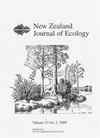Ranges of woody plant species and ferns on forested elevational gradients on Aotea-Great Barrier Island, New Zealand: the role of zones of permanent and temporary establishment
IF 1.4
3区 环境科学与生态学
Q3 ECOLOGY
引用次数: 0
Abstract
: The arrangement of plant species along elevational gradients is prominent in the debate between individualistic versus community-unit concepts in plant ecology. We obtained elevational ranges (upper and lower elevation limits) for woody species and ferns on the three highest mountains on Aotea (Great Barrier Island), Aotearoa-New Zealand. These data allowed potential species composition to be obtained for any elevation and were analysed using regression, ordination, and classification. Both woody plants and ferns demonstrated linear declines in richness with increasing elevation. The three mountains were distinct in ordination space, and their differences increased with elevation and were most marked in the fern flora. Site classifications indicated a change in composition at c. 300 m for woody plants on Hirakimata. The elevational distribution patterns of individual species differed considerably between mountains. In particular, the higher-elevation flora of the highest peak (Hirakimata) was largely absent from the other two summits, despite these being within the elevational ranges of most of the missing species. This pattern supports Steenis’s (1972) hypothesis that species will be absent from, or ephemeral on, mountains not sufficiently high to intersect their zone of permanent establishment. A second observed pattern was that widespread forest species at lower elevations often did not extend to their potential upper limits on Hirakimata. These two patterns are clear for both woody plant species and ferns. Combining Steenis’s hypothesis with inferred redistribution of elevational vegetation during the Last Glacial and Holocene periods can explain these distributional patterns新西兰澳大屏障岛森林海拔梯度上的木本植物物种和蕨类植物范围:永久和临时设施区的作用
植物物种沿海拔梯度的排列是植物生态学中个体主义与群落单位概念之争的一个突出问题。我们获得了新西兰Aotea (Great Barrier Island)三座最高山峰上木本植物和蕨类植物的海拔范围(海拔上限和海拔下限)。这些数据允许获得任何海拔的潜在物种组成,并使用回归,排序和分类进行分析。木本植物和蕨类植物的丰富度均随海拔的升高呈线性下降。3座山在排序空间上有明显的差异,且差异随海拔的升高而增大,其中蕨类植物区系差异最为显著。立地分类表明,平岛木本植物在约300 m处的组成发生了变化。不同山地间单株海拔分布格局差异较大。另外两个峰顶的海拔较高的植物群基本上没有出现,尽管这两个峰顶在大多数消失物种的海拔范围内。这种模式支持Steenis(1972)的假设,即物种将从没有足够高的山脉中消失,或者在它们永久建立的区域中短暂存在。第二个观察到的模式是,低海拔地区广泛分布的森林物种往往没有扩展到它们在平俣的潜在上限。这两种模式在木本植物和蕨类植物中都很明显。将Steenis的假设与推断出的末次冰期和全新世期间海拔植被的重新分布相结合,可以解释这些分布模式
本文章由计算机程序翻译,如有差异,请以英文原文为准。
求助全文
约1分钟内获得全文
求助全文
来源期刊

New Zealand Journal of Ecology
环境科学-生态学
CiteScore
3.00
自引率
12.50%
发文量
35
审稿时长
>36 weeks
期刊介绍:
The New Zealand Journal of Ecology is a biannual peer-reviewed journal publishing ecological research relevant to New Zealand/Aotearoa and the South Pacific. It has been published since 1952 (as a 1952 issue of New Zealand Science Review and as the Proceedings of the New Zealand Ecological Society until 1977). The Journal is published by the New Zealand Ecological Society (Inc.), and is covered by Current Contents/Agriculture, Biology and Environmental Science, GEOBASE, and Geo Abstracts.
 求助内容:
求助内容: 应助结果提醒方式:
应助结果提醒方式:


